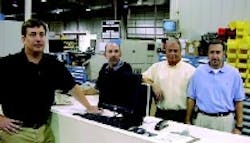Workcells And White Boards
The management team at Advance Turning (left to right) Frank Lusebrink, Chuck Parylak, Scott Halstead and John Macchia.
NO ONE AT ADVANCE TURNING & Manufacturing Inc. knew for sure if re-arranging the shop's machine tools into workcells would actually improve production. But the shop prides itself on having the courage to try new things, and in this instance, it paid off.
Advance Turning is part of the 68.6 percent of top shops identified in AMERICAN MACHINIST'S Benchmarking Survey that incorporate cellular manufacturing. Workcells/cellular manufacturing give the shop flexibility and quick responsiveness necessary to maintain a competitive edge for its high mix of jobs with low part volumes — 1,600 jobs shipped monthly with average volumes at about 70 pieces per job.
The shop uses one-piece-flow production through its 20 workcells, machining parts one-at-a-time until they are complete. "Most parts exit our production cells done, clean, in packaging containers and ready to be shipped," says Frank Lusebrink, company vice president. However, incorporating workcells and onepieceflow production forces the shop to focus intensely on such things as setup times, in-process gaging, preventative machine maintenance and production monitoring.
In one day, as many as eight jobs can run through one of Advance Turning's workcells, so reducing setup times is crucial. To accomplish this and increase work flow, the shop organizes jobs into common partshape/feature families that then run in one particular workcell involving as few machine changeovers as possible.
In addition, cell operators scan through their job lists and, if delivery schedules permit, will re-arrange jobs with similar setup aspects to run consecutively through the workcell. In doing so, they avoid having to completely breakdown machine setups.
Workcells reduce scrap and eliminate having to produce extra pieces for each job, and cell operators are supplied with all necessary gaging for conducting in-process part checks. "We don't have a specific group of inspectors. Workcell operators are responsible for quality assurance," says Lusebrink.
Prior to workcells, machines were organized in rows according processes — all the lathes together and all the mills together. Parts traveled from one area of machines to the next and from one machine operator to another, and along the way, some parts inevitably were scrapped. So to make sure it could meet job quantities, Advance Turning would machine a few extra pieces per job to make up for the scrap.
In a one-piece-flow/workcell environment Lusebrink says that preventative machine maintenance is critical because if one machine is down, the whole cell is down. To reduce down-time, Advance Turning relies heavily on its on-site maintenance team and tries to have back-up cells.
To monitor hourly performance, Advance Turning stations white boards at each workcell, and a support person regularly updates the board information. Using the boards, the shop acknowledges operators doing a good job and heads off problems before they get out of control. "The boards shorten our reaction time and help us hit production targets without scrapping parts," says Lusebrink. "They provide visibility to situations that, in the past, we were not aware of."
| Advance Turning & Manufacturing Inc. Jackson, Mich. www.advanceturning.com |
